Pentium 4 3.46 Extreme Edition and 925XE: 1066MHz FSB Support is Here
by Anand Lal Shimpi on October 31, 2004 3:00 PM EST- Posted in
- CPUs
Intel D925XECV2: Enthusiast Options
The new Intel 925XE includes adjustments for memory timings, memory speeds, memory voltage, and CPU FSB adjustments. These options are well-hidden in the Intel BIOS, but they are much more complete than you might expect on an Intel board.

The Main menu provides system information, but there is little indication of what is lurking inside the Intel BIOS. The real action for the Enthusiast is in the Advanced menu.

In the Advanced menu are the options to adjust PCI, Boot, Peripheral, Drive, Floppy, Video, USB, etc. The main controls for the Enthusiast are found in the Chipset Configuration menu
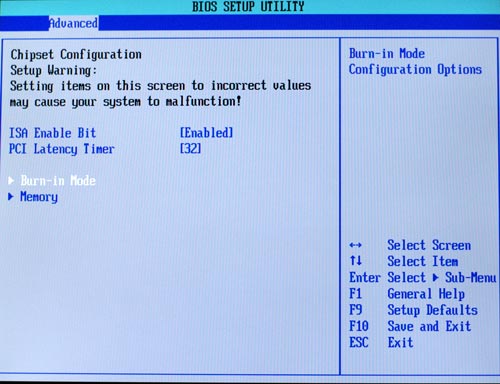
Chipset Configuration includes two important sub-menus - Burn-In Mode and memory
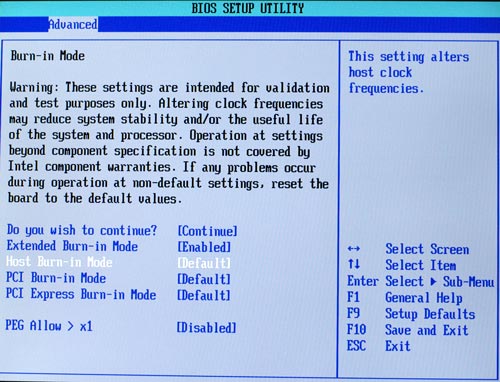
Continue and Extended Burn-In Mode should be enabled. You can then select Host Burn-In Mode.

Host Burn-In Mode now reveals an adjustment range of -2% to 10% in 1% increments. With a base frequency of 266 or 1066FSB, this is an adjustment range of 1045 FSB to 1173 FSB in 10.66MHz increments. While this is a very limited range compared to the average Enthusiast board, it is certainly a beginning for Enthusiast controls on an Intel board.

PCI speed can be adjusted form the default 33.33 to 36.36 and 40.0.
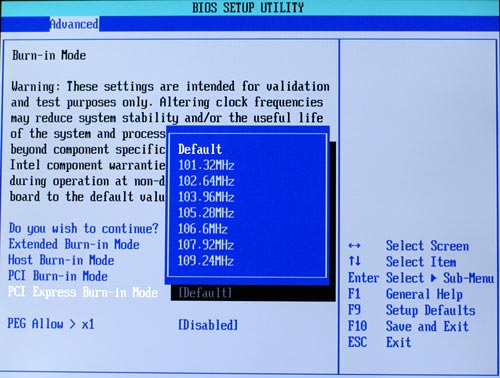
PCI Express also has an adjustment range from the default 100 to around 110 in 1.32Mhz increments.
Returning to Chipset Configuration, the Memory sub-menu has a wide range of memory adjustments.
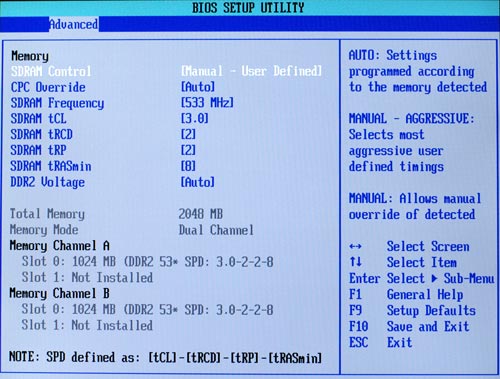
After selecting Manual-User Defined you can select memory timings. This includes CAS Latency (tCL), RAS-to-CAS Delay, tRP., and tRAS.
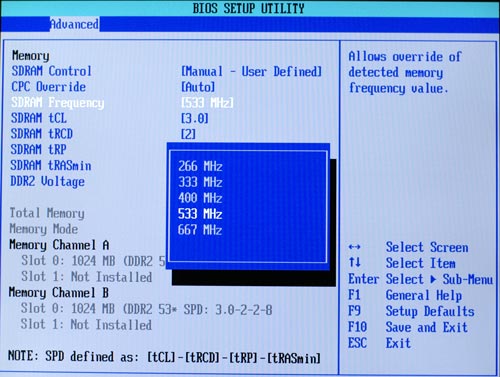
DDR2 Memory Speed can be adjusted to base frequencies of 266, 333, 400, 533, and 667.
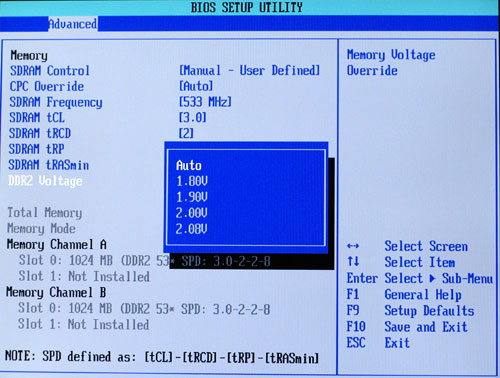
It was particularly surprising to find a reasonable range of memory voltage adjustments in the Intel BIOS. The available range is from default 1.8V to 2.1V. this is wide enough to allow many DDR533 rated DDR2 dimms to run at DDR667 or faster.
There are just two major controls missing for the Enthusiast. There is no option in the BIOS that we could find to adjust the base CPU frequency. If this could be forced to lower standard speeds such as 200 (800), there would be much more flexibility available for controlling the CPU. There is also no provision for CPU voltage, which is becoming less important as processor operating voltages have decreased. Our test CPU did have limited multiplier adjustments of 12X-13X but we do not know if shipping 1066 processors will also have this feature.
We could wish for wider ranges on several options, but the good news is this Intel board does contain the kind of tweaking controls Enthusiasts have been asking for from Intel.










63 Comments
View All Comments
IntelUser2000 - Monday, November 1, 2004 - link
Intel is not doing bad. They are doing terrible. So terrible that you might as well call them dead. Probably will last till 2009 before they fill bankruptcy.To those people who say people in forums don't know anything and that there are other people stupid enough to buy Intel chips(I mean all Intel chips): Uhh, yeah, get your head straight, since AMD is closing with Intel very rapidly in marketshare, in server, desktop, and laptop, and that means that gamers actually do make a difference(albeit slowly) making other people buy computers. You think other people will buy P4's because of high clock speed? That's BS, since people who is stupid enough to buy Intel chips don't even know what clock speeds does. There are only a very few that knows computers JUST enough to say clock speed is good.
Tides - Monday, November 1, 2004 - link
believe me, everyone wants the best they can get for the least cash.FinalFantasy - Monday, November 1, 2004 - link
Intel is not doing good right now. I know a lot of people rested their hopes for Intel to strike back with the release of this chip. But alas, we are still seeing the same problems with this chip as we've seen with it's predecessors.1. Way overpriced
2. Still getting whooped by AMD's 64-bit chips
The choice is clear here, buy an average AMD chip for a fraction of the price and still be able to outperform your friend's Intel EE based machine that he spent $2,500-3,000 on to build, while you spent about $1,500 (factor in price a person pays for an Intel EE chip and a couple of sticks of DDR2).
Pandaren - Monday, November 1, 2004 - link
What the community here forgets is that the common person doesn't care for 10 extra FPS in a game or 3 seconds faster on that photoshop filter. They want a reliable, dependable computer with good support at a reasonable price.Dell provides that with Intel chips. People honestly don't care if the Intel chip is not faster.
Those of us who do care about performance and price/performance will build our own. I replaced my Dell with a homebuilt AMD box for that reason, but I don't expect everyone to do the same.
SLIM - Monday, November 1, 2004 - link
"SLIMYou're forgetting DDR2 price which this needs in your so called Intel is "cheaper" comparison. If you want the same price setup you can get a FX-55 and really bring the wood."
ZEBO
Perhaps you didn't read my post correctly or didn't read the review, but the first paragraph in post #14 is a direct quote from the review (that's why there are QUOTATION MARKS around it). The two comments below the QUOTE were my views on Anand's conclusion of the 560 v 3800 comparison at the end of the review. Your comment actually agrees with what I said.
Tides - Monday, November 1, 2004 - link
they would if they had itswatX - Monday, November 1, 2004 - link
why doesnt intel just release a dual core platform or a 64bit chip already..gezz its like they are acting like ATI "we will release 64-vit chips only when apps start to use it" ...NotMrT - Monday, November 1, 2004 - link
Last time i remember AMD domminating this much was in the time of the thunderbirdsChapbass - Monday, November 1, 2004 - link
#43:One thing that i can vouch for, being a college student: Almost every college student not "in the know" with building systems buys a dell....because theyre sold through the college. At least my college they are. DEFINITELY the most common systems around here (and it makes me sick) : P.
It seems like households are more into HP/compaq, where schools, both k-12 and college, are totally dell.
Just something ive noticed around where im from. YMMV.
-Chap
justly - Sunday, October 31, 2004 - link
I find it interesting that the page compareing an A64 3800+ to the P4 560 shows the P4 winning the multitasking content creation. Well that isn't the interesting part, but the fact that Intel only won this because it took all three SYSmark tests is (the SYSmark tests wher the only thing Intel won in this catagory). I guess what really amuses me is remembering a comment in a article a while back (I think it was Anand himself who made the comment) implying that the SYSmark scores did not reflect the rest of their testing and that it seemed to favor Intel.